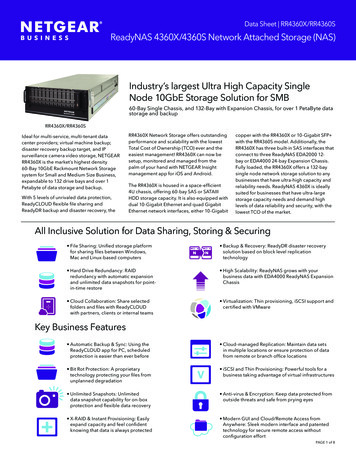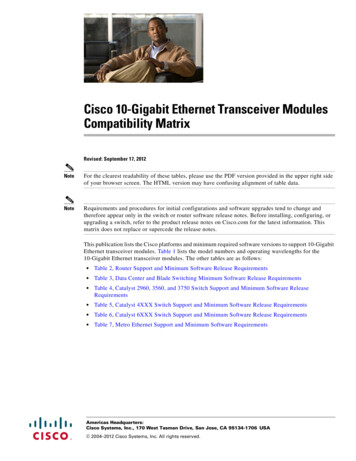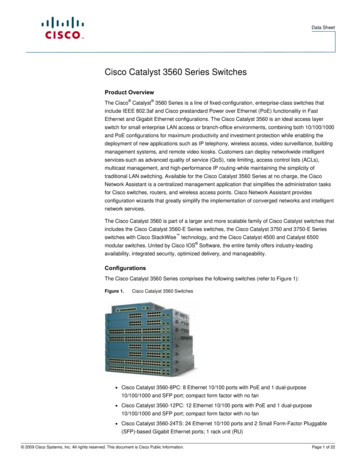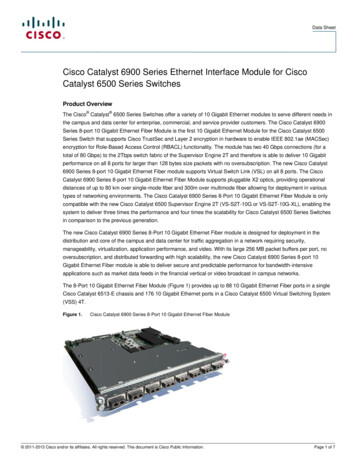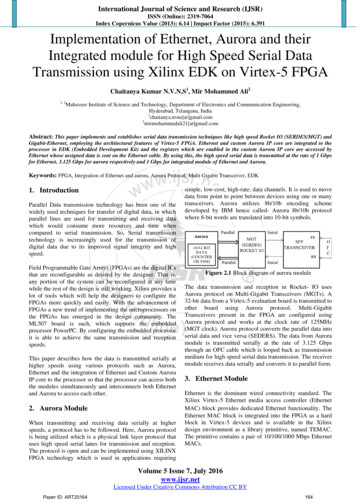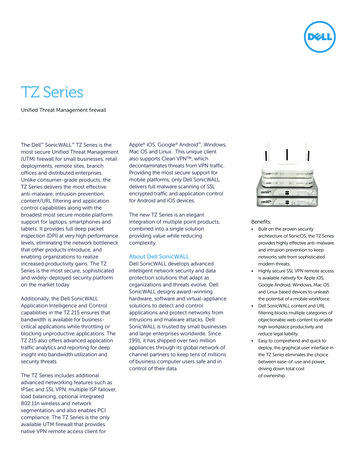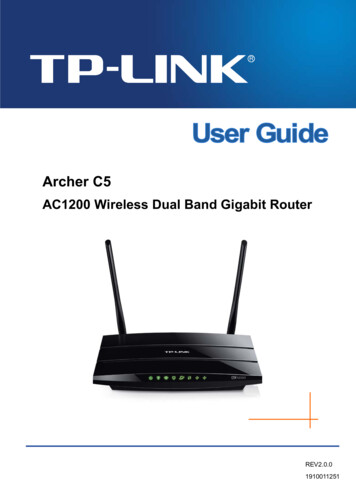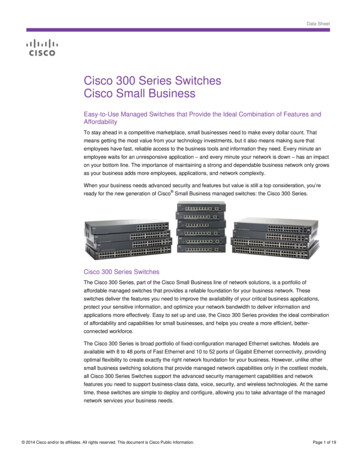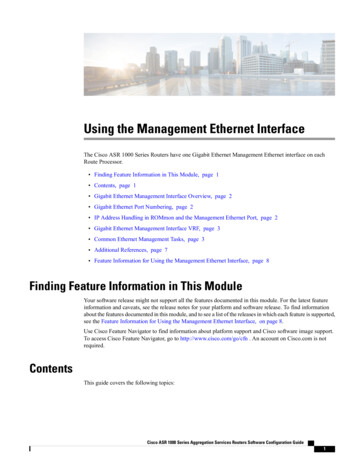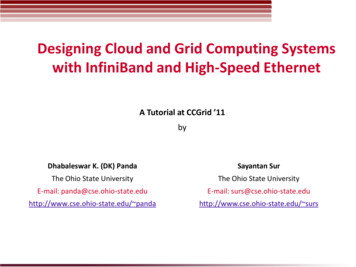
Transcription
Designing Cloud and Grid Computing Systemswith InfiniBand and High-Speed EthernetA Tutorial at CCGrid ’11byDhabaleswar K. (DK) PandaSayantan SurThe Ohio State UniversityThe Ohio State UniversityE-mail: panda@cse.ohio-state.eduE-mail: du/ pandahttp://www.cse.ohio-state.edu/ surs
Presentation Overview Introduction Why InfiniBand and High-speed Ethernet? Overview of IB, HSE, their Convergence and Features IB and HSE HW/SW Products and Installations Sample Case Studies and Performance Numbers Conclusions and Final Q&ACCGrid '112
Current and Next Generation Applications andComputing Systems Diverse Range of Applications– Processing and dataset characteristics varyGrowth of High Performance Computing– Growth in processor performance Chip density doubles every 18 months– Growth in commodity networking Increase in speed/features reducing cost Different Kinds of Systems–Clusters, Grid, Cloud, Datacenters, .CCGrid '113
Cluster Computing EnvironmentCompute clusterFrontendLANLANStorage eCCGrid '11LANMeta-DataManagerMetaDataI/O ServerNodeDataI/O ServerNodeDataI/O ServerNodeData4
Trends for Computing Clusters in the Top 500 List(http://www.top500.org)Nov. 1996: 0/500 (0%)Nov. 2001: 43/500 (8.6%)Nov. 2006: 361/500 (72.2%)Jun. 1997: 1/500 (0.2%)Jun. 2002: 80/500 (16%)Jun. 2007: 373/500 (74.6%)Nov. 1997: 1/500 (0.2%)Nov. 2002: 93/500 (18.6%)Nov. 2007: 406/500 (81.2%)Jun. 1998: 1/500 (0.2%)Jun. 2003: 149/500 (29.8%)Jun. 2008: 400/500 (80.0%)Nov. 1998: 2/500 (0.4%)Nov. 2003: 208/500 (41.6%)Nov. 2008: 410/500 (82.0%)Jun. 1999: 6/500 (1.2%)Jun. 2004: 291/500 (58.2%)Jun. 2009: 410/500 (82.0%)Nov. 1999: 7/500 (1.4%)Nov. 2004: 294/500 (58.8%)Nov. 2009: 417/500 (83.4%)Jun. 2000: 11/500 (2.2%)Jun. 2005: 304/500 (60.8%)Jun. 2010: 424/500 (84.8%)Nov. 2000: 28/500 (5.6%)Nov. 2005: 360/500 (72.0%)Nov. 2010: 415/500 (83%)Jun. 2001: 33/500 (6.6%)Jun. 2006: 364/500 (72.8%)Jun. 2011: To be announcedCCGrid '115
Grid Computing EnvironmentCompute clusterCompute clusterLANFrontendLANFrontendLANLANWANStorage clusterComputeNodeMeta-DataManagerComputeNodeI/O ServerNodeComputeNodeComputeNodeLANI/O ServerNodeI/O ServerNodeStorage O ServerNodeDataI/O ServerNodeDataI/O ServerNodeDataCompute clusterLANFrontendLANStorage eCCGrid '11Meta-DataManagerLANMetaDataI/O ServerNodeDataI/O ServerNodeDataI/O ServerNodeData6
Multi-Tier Datacenters and Enterprise ComputingEnterprise Multi-tier erRouters/Servers.Routers/ServersTier1CCGrid er.ApplicationServerTier2DatabaseServerTier37
Integrated High-End Computing EnvironmentsStorage clusterCompute NLAN/WANLANComputeNodeMeta-DataManagerMetaDataI/O ServerNodeDataI/O ServerNodeDataI/O ServerNodeDataEnterprise Multi-tier Datacenter for Visualization and s.Routers/ServersTier1CCGrid 2Tier38
Cloud Computing EnvironmentsVMVMPhysical MachineMeta-DataLocal StorageVMVMVirtual FSPhysical MachineLocal StorageVMMetaDataLANI/O ServerDataI/O ServerDataI/O ServerDataI/O ServerDataVMPhysical MachineVMLocal StorageVMPhysical MachineLocal StorageCCGrid '119
Hadoop Architecture Underlying Hadoop DistributedFile System (HDFS) Fault-tolerance by replicatingdata blocks NameNode: stores informationon data blocks DataNodes: store blocks andhost Map-reduce computation JobTracker: track jobs anddetect failure Model scales but high amountof communication duringintermediate phasesCCGrid '1110
Memcached vers Distributed Caching Layer– Allows to aggregate spare memory from multiple nodes– General purpose Typically used to cache database queries, results of API calls Scalable model, but typical usage very network intensiveCCGrid '1111
Networking and I/O Requirements Good System Area Networks with excellent performance(low latency, high bandwidth and low CPU utilization) forinter-processor communication (IPC) and I/O Good Storage Area Networks high performance I/O Good WAN connectivity in addition to intra-clusterSAN/LAN connectivity Quality of Service (QoS) for interactive applications RAS (Reliability, Availability, and Serviceability) With low costCCGrid '1112
Major Components in Computing Systems Hardware componentsP0Core0Core1Core2Core3Memory– I/O bus or linksProcessingBottlenecks– Network adapters/switchesP1Core0Core2– Processing cores and memorysubsystem Software componentsCore1I/OCore3I/O InterfaceBBottlenecksusMemory– Communication stack Bottlenecks can artificiallylimit the network performancethe user perceivesNetwork AdapterNetworkBottlenecksNetworkSwitchCCGrid '1113
Processing Bottlenecks in Traditional Protocols Ex: TCP/IP, UDP/IP Generic architecture for all networks Host processor handles almost all aspectsof communication– Data buffering (copies on sender necksP1Core0Core1Core2Core3– Data integrity (checksum)I/OMemoryBus– Routing aspects (IP routing)Network Adapter Signaling between different layers– Hardware interrupt on packet arrival ortransmissionMemoryNetworkSwitch– Software signals between different layersto handle protocol processing in differentpriority levelsCCGrid '1114
Bottlenecks in Traditional I/O Interfaces and Networks Traditionally relied on bus-basedtechnologies (last mile bottleneck)P0Core0Core1Core2Core3– E.g., PCI, PCI-XMemoryP1– One bit per wire– Performance increase through:Core0Core1Core2Core3I/OMemoryI/O InterfaceBBottlenecks Increasing clock speedus Increasing bus widthNetwork Adapter– Not scalable: Cross talk between bits Skew between wiresNetworkSwitch Signal integrity makes it difficult to increase buswidth significantly, especially for high clock speedsPCI199033MHz/32bit: 1.05Gbps (shared bidirectional)PCI-X1998 (v1.0)2003 (v2.0)133MHz/64bit: 8.5Gbps (shared bidirectional)266-533MHz/64bit: 17Gbps (shared bidirectional)CCGrid '1115
Bottlenecks on Traditional NetworksP0 Network speeds saturated ataround 1Gbps– Features provided were Core3I/O– Commodity networks were notconsidered scalable enough for verylarge-scale systemsMemoryBusNetwork AdapterNetworkBottlenecksNetworkSwitchCCGrid '11Ethernet (1979 - )10 Mbit/secFast Ethernet (1993 -)100 Mbit/secGigabit Ethernet (1995 -)1000 Mbit /secATM (1995 -)155/622/1024 Mbit/secMyrinet (1993 -)1 Gbit/secFibre Channel (1994 -)1 Gbit/sec16
Motivation for InfiniBand and High-speed Ethernet Industry Networking Standards InfiniBand and High-speed Ethernet were introduced intothe market to address these bottlenecks InfiniBand aimed at all three bottlenecks (protocolprocessing, I/O bus, and network speed) Ethernet aimed at directly handling the network speedbottleneck and relying on complementary technologies toalleviate the protocol processing and I/O bus bottlenecksCCGrid '1117
Presentation Overview Introduction Why InfiniBand and High-speed Ethernet? Overview of IB, HSE, their Convergence and Features IB and HSE HW/SW Products and Installations Sample Case Studies and Performance Numbers Conclusions and Final Q&ACCGrid '1118
IB Trade Association IB Trade Association was formed with seven industry leaders(Compaq, Dell, HP, IBM, Intel, Microsoft, and Sun) Goal: To design a scalable and high performance communicationand I/O architecture by taking an integrated view of computing,networking, and storage technologies Many other industry participated in the effort to define the IBarchitecture specification IB Architecture (Volume 1, Version 1.0) was released to publicon Oct 24, 2000– Latest version 1.2.1 released January 2008 http://www.infinibandta.orgCCGrid '1119
High-speed Ethernet Consortium (10GE/40GE/100GE) 10GE Alliance formed by several industry leaders to takethe Ethernet family to the next speed step Goal: To achieve a scalable and high performancecommunication architecture while maintaining backwardcompatibility with Ethernet http://www.ethernetalliance.org 40-Gbps (Servers) and 100-Gbps Ethernet (Backbones,Switches, Routers): IEEE 802.3 WG Energy-efficient and power-conscious protocols– On-the-fly link speed reduction for under-utilized linksCCGrid '1120
Tackling Communication Bottlenecks with IB and HSE Network speed bottlenecks Protocol processing bottlenecks I/O interface bottlenecksCCGrid '1121
Network Bottleneck Alleviation: InfiniBand (“InfiniteBandwidth”) and High-speed Ethernet (10/40/100 GE) Bit serial differential signaling– Independent pairs of wires to transmit independentdata (called a lane)– Scalable to any number of lanes– Easy to increase clock speed of lanes (since each laneconsists only of a pair of wires) Theoretically, no perceived limit on thebandwidthCCGrid '1122
Network Speed Acceleration with IB and HSEEthernet (1979 - )10 Mbit/secFast Ethernet (1993 -)100 Mbit/secGigabit Ethernet (1995 -)1000 Mbit /secATM (1995 -)155/622/1024 Mbit/secMyrinet (1993 -)1 Gbit/secFibre Channel (1994 -)1 Gbit/secInfiniBand (2001 -)2 Gbit/sec (1X SDR)10-Gigabit Ethernet (2001 -)10 Gbit/secInfiniBand (2003 -)8 Gbit/sec (4X SDR)InfiniBand (2005 -)16 Gbit/sec (4X DDR)24 Gbit/sec (12X SDR)InfiniBand (2007 -)32 Gbit/sec (4X QDR)40-Gigabit Ethernet (2010 -)40 Gbit/secInfiniBand (2011 -)56 Gbit/sec (4X FDR)InfiniBand (2012 -)100 Gbit/sec (4X EDR)20 times in the last 9 yearsCCGrid '1123
InfiniBand Link Speed Standardization RoadmapPer Lane & Rounded Per Link Bandwidth (Gb/s)# ofLanes IB-EDR(25.78125)1248 4896 96168 168300 300832 3264 64112 112200 200416 1632 3256 56100 10014 48 814 1425 25NDR Next Data RateHDR High Data RateEDR Enhanced Data RateFDR Fourteen Data RateQDR Quad Data RateDDR Double Data RateSDR Single Data Rate (not shown)12x NDR12x HDR8x NDR300G-IB-EDR168G-IB-FDR8x HDR4x NDRBandwidth per direction (Gbps)96G-IB-QDR200G-IB-EDR112G-IB-FDR4x HDR48G-IB-DDR48G-IB-QDRx12100G-IB-EDR56G-IB-FDR1x NDR1x 516G-IB-DDR8G-IB-QDRx1-2006CCGrid '11-2007-2008-2009-2010-2011201524
Tackling Communication Bottlenecks with IB and HSE Network speed bottlenecks Protocol processing bottlenecks I/O interface bottlenecksCCGrid '1125
Capabilities of High-Performance Networks Intelligent Network Interface Cards Support entire protocol processing completely in hardware(hardware protocol offload engines) Provide a rich communication interface to applications– User-level communication capability– Gets rid of intermediate data buffering requirements No software signaling between communication layers– All layers are implemented on a dedicated hardware unit, and noton a shared host CPUCCGrid '1126
Previous High-Performance Network Stacks Fast Messages (FM)– Developed by UIUC Myricom GM– Proprietary protocol stack from Myricom These network stacks set the trend for high-performancecommunication requirements– Hardware offloaded protocol stack– Support for fast and secure user-level access to the protocol stack Virtual Interface Architecture (VIA)– Standardized by Intel, Compaq, Microsoft– Precursor to IBCCGrid '1127
IB Hardware Acceleration Some IB models have multiple hardware accelerators– E.g., Mellanox IB adapters Protocol Offload Engines– Completely implement ISO/OSI layers 2-4 (link layer, network layerand transport layer) in hardware Additional hardware supported features also present– RDMA, Multicast, QoS, Fault Tolerance, and many moreCCGrid '1128
Ethernet Hardware Acceleration Interrupt Coalescing– Improves throughput, but degrades latency Jumbo Frames– No latency impact; Incompatible with existing switches Hardware Checksum Engines– Checksum performed in hardware significantly faster– Shown to have minimal benefit independently Segmentation Offload Engines (a.k.a. Virtual MTU)– Host processor “thinks” that the adapter supports large Jumboframes, but the adapter splits it into regular sized (1500-byte) frames– Supported by most HSE products because of its backwardcompatibility considered “regular” Ethernet– Heavily used in the “server-on-steroids” model High performance servers connected to regular clientsCCGrid '1129
TOE and iWARP Accelerators TCP Offload Engines (TOE)– Hardware Acceleration for the entire TCP/IP stack– Initially patented by Tehuti Networks– Actually refers to the IC on the network adapter that implementsTCP/IP– In practice, usually referred to as the entire network adapter Internet Wide-Area RDMA Protocol (iWARP)– Standardized by IETF and the RDMA Consortium– Support acceleration features (like IB) for Ethernet http://www.ietf.org & http://www.rdmaconsortium.orgCCGrid '1130
Converged (Enhanced) Ethernet (CEE or CE) Also known as “Datacenter Ethernet” or “Lossless Ethernet”– Combines a number of optional Ethernet standards into one umbrellaas mandatory requirements Sample enhancements include:– Priority-based flow-control: Link-level flow control for each Class ofService (CoS)– Enhanced Transmission Selection (ETS): Bandwidth assignment toeach CoS– Datacenter Bridging Exchange Protocols (DBX): Congestionnotification, Priority classes– End-to-end Congestion notification: Per flow congestion control tosupplement per link flow controlCCGrid '1131
Tackling Communication Bottlenecks with IB and HSE Network speed bottlenecks Protocol processing bottlenecks I/O interface bottlenecksCCGrid '1132
Interplay with I/O Technologies InfiniBand initially intended to replace I/O bustechnologies with networking-like technology– That is, bit serial differential signaling– With enhancements in I/O technologies that use a similararchitecture (HyperTransport, PCI Express), this has becomemostly irrelevant now Both IB and HSE today come as network adapters that pluginto existing I/O technologiesCCGrid '1133
Trends in I/O Interfaces with Servers Recent trends in I/O interfaces show that they are nearlymatching head-to-head with network speeds (though theystill lag a little bit)PCI199033MHz/32bit: 1.05Gbps (shared bidirectional)PCI-X1998 (v1.0)2003 (v2.0)133MHz/64bit: 8.5Gbps (shared bidirectional)266-533MHz/64bit: 17Gbps (shared bidirectional)AMD HyperTransport (HT)2001 (v1.0), 2004 (v2.0)2006 (v3.0), 2008 (v3.1)102.4Gbps (v1.0), 179.2Gbps (v2.0)332.8Gbps (v3.0), 409.6Gbps (v3.1)(32 lanes)PCI-Express (PCIe)by Intel2003 (Gen1), 2007 (Gen2)2009 (Gen3 standard)Gen1: 4X (8Gbps), 8X (16Gbps), 16X (32Gbps)Gen2: 4X (16Gbps), 8X (32Gbps), 16X (64Gbps)Gen3: 4X ( 32Gbps), 8X ( 64Gbps), 16X ( 128Gbps)Intel QuickPathInterconnect (QPI)2009153.6-204.8Gbps (20 lanes)CCGrid '1134
Presentation Overview Introduction Why InfiniBand and High-speed Ethernet? Overview of IB, HSE, their Convergence and Features IB and HSE HW/SW Products and Installations Sample Case Studies and Performance Numbers Conclusions and Final Q&ACCGrid '1135
IB, HSE and their Convergence InfiniBand– Architecture and Basic Hardware Components– Communication Model and Semantics– Novel Features– Subnet Management and Services High-speed Ethernet Family– Internet Wide Area RDMA Protocol (iWARP)– Alternate vendor-specific protocol stacks InfiniBand/Ethernet Convergence Technologies– Virtual Protocol Interconnect (VPI)– (InfiniBand) RDMA over Ethernet (RoE)– (InfiniBand) RDMA over Converged (Enhanced) Ethernet (RoCE)CCGrid '1136
Comparing InfiniBand with Traditional Networking StackHTTP, FTP, MPI,File SystemsApplication LayerApplication LayerOpenFabrics VerbsSockets InterfaceTCP, UDPRoutingDNS management toolsFlow-control andError DetectionCopper, Optical or WirelessCCGrid '11MPI, PGAS, File SystemsTransport LayerTransport LayerNetwork LayerNetwork LayerLink LayerLink LayerPhysical LayerPhysical LayerTraditional EthernetInfiniBandRC (reliable), UD (unreliable)RoutingFlow-control, Error DetectionOpenSM (management tool)Copper or Optical37
IB Overview InfiniBand– Architecture and Basic Hardware Components– Communication Model and Semantics Communication Model Memory registration and protection Channel and memory semantics– Novel Features Hardware Protocol Offload– Link, network and transport layer features– Subnet Management and ServicesCCGrid '1138
Components: Channel Adapters Used by processing and I/O units to Programmable DMA engines withQPChannel Adapter DMAPortPortVLVL VLVLVLVLVLVL SMAMTPCTransportprotection features May have multiple portsQPQPQP Consume & generate IB packetsMemory VLconnect to fabricPort– Independent buffering channeledthrough Virtual Lanes Host Channel Adapters (HCAs)CCGrid '1139
Components: Switches and RoutersSwitch PortPort VLVLVL VLVLVL VLVLVLPacket RelayPortRouterPortPort VLVLVL VLVLVL VLVLVLGRH Packet RelayPort Relay packets from a link to another Switches: intra-subnet Routers: inter-subnet May support multicastCCGrid '1140
Components: Links & Repeaters Network Links– Copper, Optical, Printed Circuit wiring on Back Plane– Not directly addressable Traditional adapters built for copper cabling– Restricted by cable length (signal integrity)– For example, QDR copper cables are restricted to 7m Intel Connects: Optical cables with Copper-to-opticalconversion hubs (acquired by Emcore)– Up to 100m length– 550 picosecondscopper-to-optical conversion latency Available from other vendors (Luxtera)(Courtesy Intel) Repeaters (Vol. 2 of InfiniBand specification)CCGrid '1141
IB Overview InfiniBand– Architecture and Basic Hardware Components– Communication Model and Semantics Communication Model Memory registration and protection Channel and memory semantics– Novel Features Hardware Protocol Offload– Link, network and transport layer features– Subnet Management and ServicesCCGrid '1142
IB Communication ModelBasic InfiniBandCommunicationSemanticsCCGrid '1143
Queue Pair Model Each QP has two queues– Send Queue (SQ)– Receive Queue (RQ)QPSendCQRecvWQEsCQEs– Work requests are queued to the QP(WQEs: “Wookies”)InfiniBand Device QP to be linked to a Complete Queue(CQ)– Gives notification of operationcompletion from QPs– Completed WQEs are placed in theCQ with additional information(CQEs: “Cookies”)CCGrid '1144
Memory RegistrationBefore we do any communication:All memory used for communication mustbe registered 4Kernel2Send virtual address and lengthHCA/RNICProcess cannot map memorythat it does not own (security !)3. HCA caches the virtual to physicalmapping and issues a handle 3CCGrid '11 2. Kernel handles virtual- physicalmapping and pins region intophysical memoryProcess11. Registration RequestIncludes an l key and r key4. Handle is returned to application45
Memory ProtectionFor security, keys are required for alloperations that touch buffers To send or receive data the l keymust be provided to the HCAProcess HCA verifies access to localmemoryl keyKernelHCA/NIC For RDMA, initiator must have ther key for the remote virtual address Possibly exchanged with asend/recv r key is not encrypted in IBr key is needed for RDMA operationsCCGrid '1146
Communication in the Channel Semantics(Send/Receive tQPCQSendRecvProcessor is involved only to:QPSendRecvCQ1. Post receive WQE2. Post send WQE3. Pull out completed CQEs from the CQInfiniBand DeviceSend WQE contains information about thesend buffer (multiple non-contiguoussegments)CCGrid '11Hardware ACKInfiniBand DeviceReceive WQE contains information on the receivebuffer (multiple non-contiguous segments);Incoming messages have to be matched to areceive WQE to know where to place47
Communication in the Memory Semantics (RDMA emorySegmentMemorySegmentMemorySegmentQPInitiator processor is involved only to:SendRecvRecv1. Post send WQE2. Pull out completed CQE from the send CQQPCQSendCQNo involvement from the target processorInfiniBand DeviceHardware ACKInfiniBand DeviceSend WQE contains information about thesend buffer (multiple segments) and thereceive buffer (single segment)CCGrid '1148
Communication in the Memory Semantics tiator processor is involved only to:SendRecvRecv1. Post send WQE2. Pull out completed CQE from the send CQQPCQSendCQNo involvement from the target processorInfiniBand DeviceSend WQE contains information about thesend buffer (single 64-bit segment) and thereceive buffer (single 64-bit segment)CCGrid '11OPInfiniBand DeviceIB supports compare-and-swap andfetch-and-add atomic operations49
IB Overview InfiniBand– Architecture and Basic Hardware Components– Communication Model and Semantics Communication Model Memory registration and protection Channel and memory semantics– Novel Features Hardware Protocol Offload– Link, network and transport layer features– Subnet Management and ServicesCCGrid '1150
Hardware Protocol OffloadCompleteHardwareImplementationsExistCCGrid '1151
Link/Network Layer Capabilities Buffering and Flow Control Virtual Lanes, Service Levels and QoS Switching and MulticastCCGrid '1152
Buffering and Flow Control IB provides three-levels of communication throttling/controlmechanisms– Link-level flow control (link layer feature)– Message-level flow control (transport layer feature): discussed later– Congestion control (part of the link layer features) IB provides an absolute credit-based flow-control– Receiver guarantees that enough space is allotted for N blocks of data– Occasional update of available credits by the receiver Has no relation to the number of messages, but only to thetotal amount of data being sent– One 1MB message is equivalent to 1024 1KB messages (except forrounding off at message boundaries)CCGrid '1153
Virtual Lanes Multiple virtual links withinsame physical link– Between 2 and 16 Separate buffers and flowcontrol– Avoids Head-of-LineBlocking VL15: reserved formanagement Each port supports one ormore data VLCCGrid '1154
Service Levels and QoS Service Level (SL):– Packets may operate at one of 16 different SLs– Meaning not defined by IB SL to VL mapping:– SL determines which VL on the next link is to be used– Each port (switches, routers, end nodes) has a SL to VL mappingtable configured by the subnet management Partitions:– Fabric administration (through Subnet Manager) may assignspecific SLs to different partitions to isolate traffic flowsCCGrid '1155
Traffic Segregation BenefitsIPC, Load Balancing, Web Caches, ASPServersServersServersVirtual LanesInfiniBandNetworkInfiniBandFabricFabricIP NetworkRouters, SwitchesVPN’s, DSLAMsStorage Area NetworkRAID, NAS, Backup(Courtesy: Mellanox Technologies)CCGrid '11 InfiniBand Virtual Lanesallow the multiplexing ofmultiple independent logicaltraffic flows on the samephysical link Providing the benefits ofindependent, separatenetworks while eliminatingthe cost and difficultiesassociated with maintainingtwo or more networks56
Switching (Layer-2 Routing) and Multicast Each port has one or more associated LIDs (LocalIdentifiers)– Switches look up which port to forward a packet to based on itsdestination LID (DLID)– This information is maintained at the switch For multicast packets, the switch needs to maintainmultiple output ports to forward the packet to– Packet is replicated to each appropriate output port– Ensures at-most once delivery & loop-free forwarding– There is an interface for a group management protocol Create, join/leave, prune, delete groupCCGrid '1157
Switch Complex Basic unit of switching is a crossbar– Current InfiniBand products use either 24-port (DDR) or 36-port(QDR) crossbars Switches available in the market are typically collections ofcrossbars within a single cabinet Do not confuse “non-blocking switches” with “crossbars”– Crossbars provide all-to-all connectivity to all connected nodes For any random node pair selection, all communication is non-blocking– Non-blocking switches provide a fat-tree of many crossbars For any random node pair selection, there exists a switchconfiguration such that communication is non-blocking If the communication pattern changes, the same switch configurationmight no longer provide fully non-blocking communicationCCGrid '1158
IB Switching/Routing: An ExampleAn Example IB Switch Block Diagram (Mellanox 144-Port)Switching: IB supportsVirtual Cut Through (VCT)Spine Blocks1 2 3 4P2P1LID: 2LID: 4Leaf BlocksDLIDOut-PortForwarding Table2144 Someone has to setup the forwarding tables andgive every port an LID– “Subnet Manager” does this work Different routing algorithms give different pathsCCGrid '11Routing: Unspecified by IB SPECUp*/Down*, Shift are popularrouting engines supported by OFED Fat-Tree is a populartopology for IB Cluster– Different over-subscriptionratio may be used Other topologies are alsobeing used– 3D Torus (Sandia Red Sky)and SGI Altix (Hypercube)59
More on Multipathing Similar to basic switching, except – sender can utilize multiple LIDs associated to the samedestination port Packets sent to one DLID take a fixed path Different packets can be sent using different DLIDs Each DLID can have a different path (switch can be configureddifferently for each DLID) Can cause out-of-order arrival of packets– IB uses a simplistic approach: If packets in one connection arrive out-of-order, they are dropped– Easier to use different DLIDs for different connections This is what most high-level libraries using IB do!CCGrid '1160
IB Multicast ExampleCCGrid '1161
Hardware Protocol OffloadCompleteHardwareImplementationsExistCCGrid '1162
IB Transport ServicesService e ConnectionYesYesIBAUnreliable ConnectionYesNoIBAReliable DatagramNoYesIBAUnreliable DatagramNoNoIBARAW DatagramNoNoRaw Each transport service can have zero or more QPsassociated with it– E.g., you can have four QPs based on RC and one QP based on UDCCGrid '1163
Trade-offs in Different Transport TypesAttributeScalability(M processes, Nnodes)ReliableConnectionM2N QPsper HCAReliableDatagramM QPsper nreliableDatagramMN QPsper HCAM2N QPsper HCAM QPsper HCAReliabilityCorruptdatadetectedData delivered exactly onceData OrderGuaranteesOne source tomultipledestinationsErrorRecoveryCCGrid '111 QPper HCAYesDataDeliveryGuaranteeData LossDetectedRawDatagramPer connectionPer connectionNo guaranteesUnordered,duplicate datadetectedYesErrors (retransmissions, alternate path, etc.)handled by transport layer. Client only involved inhandling fatal errors (links broken, protectionviolation, etc.)Packets witherrors andsequenceerrors arereported toresponderNoNoNoNoNoneNone64
Transport Layer Capabilities Data Segmentation Transaction Ordering Message-level Flow Control Static Rate Control and Auto-negotiationCCGrid '1165
Data Segmentation IB transport layer provides a message-level communicationgranularity, not byte-level (unlike TCP) Application can hand over a large message– Network adapter segments it to MTU sized packets– Single notification when the entire message is transmitted orreceived (not per packet) Reduced host overhead to send/receive messages– Depends on the number of messages, not the number of bytesCCGrid '1166
Transaction Ordering IB follows a strong transaction ordering for RC Sender network adapter transmits messages in the orderin which WQEs were posted Each QP utilizes a single LID– All WQEs posted on same QP take the same path– All packets are received by the receiver in the same order– All receive WQEs are completed in the order in which they werepostedCCGrid '1167
Message-level Flow-Control Also called as End-to-end Flow-control– Does not depend on the number of network hops Separate from Link-level Flow-Control– Link-level flow-control only relies on the number of bytes beingtransmitted, not the number of messages– Message-level flow-control only relies on the number of messagestransferred, not the number of bytes If 5 receive WQEs are posted, the sender can send 5messages (can post 5 send WQEs)– If the sent messages are larger than what the receive buffers areposted, flow-control cannot handle itCCGrid '1168
Static Rate Control and Auto-Negotiation IB allows link rates to be statically changed– On a 4X link, we can set data to be sent at 1X– For heterogeneous links, rate can be set to the lowest link rate– Useful for low-priority traffic Auto-negotiation also available– E.g., if you connect a 4X adapter to a 1X switch, data isautomatically sent at 1X rate Only fixed settings available– Cannot set rate requirement to 3.16 Gbps, for exampleCCGrid '1169
IB Overview InfiniBand– Architecture and Basic Hardware Components– Communication Model and Semantics Communication Model Memory registration and protection Channel and memory semantics– Novel Features Hardware Protocol Offload– Link, network and transport layer features– Subnet Management and ServicesCCGrid '1170
Concepts in IB Management Agents– Processes or hardware units running on each adapter, switch,router (everything on the network)– Provide capability to query and set parameters Managers– Make high-level decisions and imp
Industry Networking Standards InfiniBand and High-speed Ethernet were introduced into the market to address these bottlenecks InfiniBand aimed at all three bottlenecks (protocol processing, I/O bus, and network speed) Ethernet aimed at directly handling the network speed bottleneck and relying on complementary technologies to
